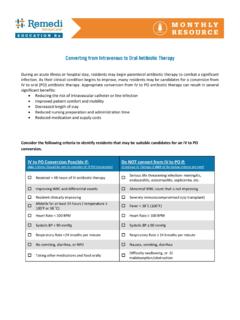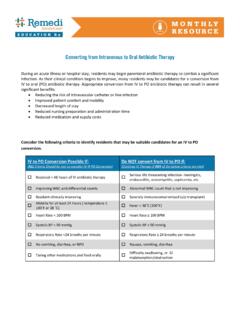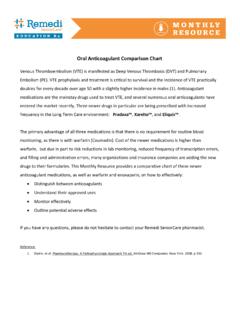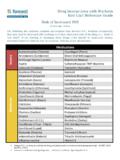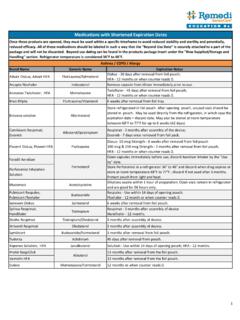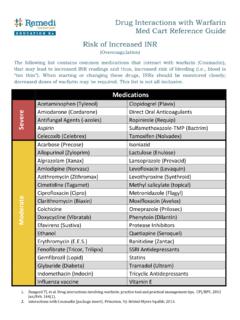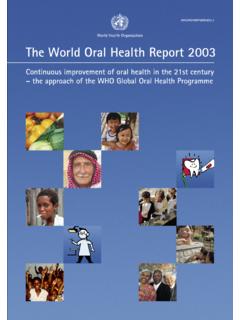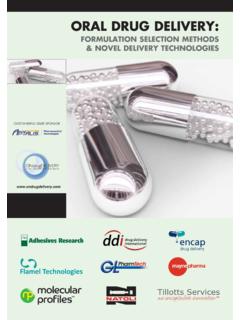Transcription of Converting from Intravenous to Oral Antibiotic …
1 Converting from Intravenous to oral Antibiotic therapy During an acute illness or hospital stay, residents may begin parenteral Antibiotic therapy to combat a significant infection. As their clinical condition begins to improve, many residents may be candidates for a conversion from IV to oral (PO) Antibiotic therapy . Appropriate conversion from IV to PO Antibiotic therapy can result in several significant benefits: Reducing the risk of intravascular catheter or line infection Improved patient comfort and mobility Decreased length of stay Reduced nursing preparation and administration time Reduced medication and supply costs Consider the following criteria to identify residents that may be suitable candidates for an IV to PO conversion.
2 IV to PO Conversion Possible If: (ALL Criteria Should be met to consider IV PO Conversion) Do NOT convert from IV to PO if: (Continue IV therapy if ANY of the below criteria are met) Received > 48 hours of IV Antibiotic therapy Serious life threatening infection- meningitis, endocarditis, osteomyelitis, septicemia, etc. Improving WBC and differential counts Abnormal WBC count that is not improving Resident clinically improving Severely immunocompromised (s/p transplant) Afebrile for at least 24 hours ( temperature 100 F or 38 C) Fever > 38 C (100 F) Heart Rate < 100 BPM Heart Rate 100 BPM Systolic BP > 90 mmHg Systolic BP 90 mmHg Respiratory Rate <24 breaths per minute Respiratory Rate 24 breaths per minute No vomiting, diarrhea, or NPO Nausea, vomiting, diarrhea Taking other medications and food orally Difficulty swallowing, or GI malabsorption/obstruction Listed below are a number of commonly used antibiotics known to have virtually equivalent bioavailability when given by either the IV or PO routes.
3 However, the final decision to convert a resident from IV to PO therapy should be based on the individual resident s clinical condition and available laboratory data. Once switched, residents should be closely monitored for changing conditions over the next 24-48 hours. Medication Brand name Parenteral Dose PO Conversion (tablet or capsule) Azithromycin Zithromax 250 mg IV once daily 250 mg PO once daily 500 mg IV once daily 500 mg PO once daily Ciprofloxacin Cipro 200 mg IV once daily 250 mg PO once daily 200 mg IV Q12H 250 mg PO Q12H 400 mg IV once daily 500 mg PO once daily 400 mg IV Q12H 500 mg PO Q12H 400 mg IV Q8H 750 mg PO Q12H Clindamycin Cleocin 300mg IV Q6-8H 150 mg PO Q6-8H 600 mg IV Q6-8H 300 mg PO Q6-8H Doxycycline Doxy 100 mg IV Q12H 100 mg PO Q12H Fluconazole Diflucan 100 mg IV once daily 100 mg PO once daily 200 mg IV once daily 200 mg PO once daily 400 mg IV once daily 400 mg PO once daily Levofloxacin Levaquin 250 mg IV once daily 250 mg PO once daily 500 mg IV once daily 500 mg PO once daily 750 mg IV once daily 750 mg PO
4 Once daily Linezolid Zyvox 600 mg IV Q12H 600 mg PO Q12H Metronidazole Flagyl 250 mg IV Q6H 250 mg PO Q6H 500 mg IV Q6H 500 mg PO Q6H 500 mg IV Q8-12H 500 mg PO Q8-12H Trimethoprim/sulfamethoxazole Bactrim 800 mg/160 mg IV Q12H 800 mg/160 mg PO Q12H References 1. Algorithms Promoting Antimicrobial Stewardship in Long Term care. BJ Zarowitz et al. JAMDA. 2016; (17): 173-178. 2. Considerations for PO to IV dose conversions. Pharmacist's Letter/Prescriber's Letter. 2010;26(9):260912. 3. Kuti JL, Le TN, Nightingale CH, Nicolau DP, Quintiliani R. Pharmacoeconomics of a pharmacist-managed program for automatically Converting levofloxacin route from IV to oral . Am J Health-Syst Pharm. 2002; 59(22):2209-2215. 4.
5 Mertz D, Koller M, Haller P, et al. Outcomes of early switching from Intravenous to oral antibiotics on medical wards. J Antimicrob Chemother. 2009;64(1):188-199.
